Conserving and restoring the iconic marshes of Southern Iraq

The iconic Mesopotamian Marshlands in Iraq, often referred to as the ‘Garden of Eden’, also contain the giant Majnoon oil fields. The wetlands were severely damaged by past drainage and warfare. Water availability is still constraining both marshland restoration and the oil industry. We are working with Shell to minimise the negative impacts of oil and gas development on the biodiversity of the marshes and the ecosystem services they provide and to help restore them.
The famous Mesopotamian Marshlands in the lower floodplains of the Euphrates and the Tigris are the largest wetland in the Middle East. The marshes are home to hundreds of thousands of birds and are a stopover point for many migratory birds, including several ducks, pelicans and herons as they travel from Central Asia to Africa. The marshes are home to more than 200 species of birds and at least 40 fish species. This is also where the Majnoon Oil Field is located: one of the largest oil fields in the world. The word ‘majnoon’ in Arabic means ‘crazy’, referring to the excessive amounts of oil. Here Shell (Shell Iraq Petroleum Development – SIPD) is developing a very large project, which overlaps with the only Ramsar Wetland of International Importance in Iraq.
Challenges
By the year 2000 up to 90% of the marshes were destroyed and their inhabitants fled, mostly due to the large scale drainage during the Saddam Hussein regime. In the last few decades the region has also been the scene of several wars. Extensive areas are still littered with one of the highest densities in the world of mines and unexploded ordinance. Through all of this, only a small part of the marshes on the border with Iran, the Hawizeh Marshes, has remained and is the first Ramsar Wetland of International Importance in Iraq. The other two parts of the marshes were designated as Ramsar sites in 2014.
After the fall of the regime and end of the wars around 40-60% of the marshes were reflooded again. A large part of the marshlands, together with three ancient cities, has now been inscribed on UNESCO’s World Heritage List.
However, conservation and restoration of these wetlands face serious constraints due to developments, such as agricultural schemes and large dams further upstream , which reduce the availability of water. Solutions need to be found so that the precious river water available is used wisely for the marshes, drinking water and agriculture, and that the oil industry does not compete for water or pollute the area.

Achievements
We worked with Shell to make sure that the oil field developments are taking place with minimal negative impacts on the marshes and the services they provide, and that future developments contribute to the restoration of the marshes by:
- Identification of environmental issues and stakeholders.
- Contribution to the development and review of a Biodiversity Action Plan (BAP), on baseline surveys for biodiversity and the importance for local communities and the regional economy.
- On-going dialogue with Shell on the planning and design of all installations and activities so that they do not affect the marshes.
- Demonstration that re-flooding of currently dried out land can revitalise biodiversity and benefit local communities, and therefore needs to be seriously taken into consideration in future planning of marsh restoration and hazard reduction.
- Identification of further opportunities for marshland restoration, involving the SIPD staff, local communities and authorities.
- For UNEP we carried out a global comparative analysis of the Iraqi Marshlands for biological diversity and institutional management as part of the nomination of the Mesopotamian Marshlands as a World Heritage site.
Links
This video provides an overview of the many challenges facing the marshes.
Partners:
Shell
Nature Iraq
Ramsar Convention
IUCN West Asia
UNEP-UNESCO Joint Project in Iraq
